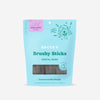
Unfortunately, allergies are common in all dog breeds, often appearing after a dog turns 6 months old. Sometimes, however, it’s difficult to pinpoint whether or not your dog is having an allergic reaction or is experiencing some kind of illness. Always consult your veterinarian if you suspect your dog has allergies. It’s important to know the cause and symptoms of your pet’s allergies because those factors will help your veterinarian determine which of the various ways you can give them some relief.
But what do allergies look like? And how can we, as pet owners, mitigate some of their pesky symptoms?
Different Kinds of Allergies
Skin allergies are typically caused by fleas, food allergies, or environmental factors. It’s important to keep a close eye on your dog’s coat and look for signs of skin allergies, such as red or inflamed skin, increased itching, and hives. If you’re able to narrow down the cause of the reaction, you’ll have a better chance of preventing exposure in the future and shortening recovery time.
Fleas
Follow your vet’s instructions for a flea/tick treatment to avoid fleas causing skin allergies. The more time your dog spends outside, the greater the chance of fleas taking hold of your dog if unprotected. Itching is the most common symptom, though a dog who chews at their skin to itch may also develop secondary skin infections as a result. If your dog is already affected, treat with flea medication or sprays.
Food Allergies
Allergic reactions to certain foods can also cause itchy skin and gastrointestinal issues associated with skin allergies. When a food sensitivity causes an allergic reaction, your dog may have itchy skin, hives, facial swelling, vomiting, and/or diarrhea. The best thing to do when you suspect a food sensitivity is to work with your vet on an elimination trial to find the cause of the reaction.
Environmental Causes
Environmental causes for skin allergies are things like dust, pollen, fungus, and mold. Symptoms are most seen in irritated paws and ears, though they can also show in other body parts such as the eyes, paw pads, and groin. Typically, environmental causes are seasonal. Fortunately, there are plenty of options to treat seasonal allergies, such as special baths and supplements described here.
General Allergy Symptoms
Besides the previously mentioned symptoms associated with allergies, there are some other red flags that may point to an allergic reaction. Hives and rashes are common in skin allergies. More obvious symptoms include sneezing, water eyes, and a runny nose, just as people experience with allergies. Swelling of the face and throat can be associated with allergies and require an antihistamine. Though, fortunately, less common, some dogs may even go into anaphylactic shock, especially when experiencing a reaction to bee stings, vaccine, or even an extreme food allergy. This rare but extreme reaction needs immediate veterinary attention.



